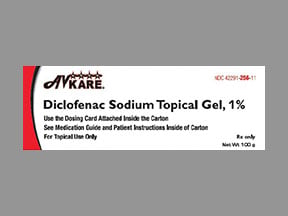
Diclofenac Sodium Coupons & Savings Card – Discount Prices from $10.86
Generic for: Pennsaid, Enovarx-diclofenac sodium, Goodsense arthritis pain
My prescription
Edit
100GM of 1%, Diclofenac Sodium (1 Tube)
Select pharmacy

Albertsons
$10.86
COUPON PRICE
Walgreens
$10.99
COUPON PRICE
Walmart
$19.56
COUPON PRICEDiclofenac Sodium savings card
Show this card to your pharmacist
Albertsons
$10.86
BIN
ID
PCN
GRP
011867
LH3A0E255A
HT
LABH001
Powered by
More prescriptions for rheumatoid arthritis
More prescriptions for rheumatoid arthritis
Price history for Goodsense Arthritis Pain (brand) & Diclofenac Sodium (generic)
1 Tube, 100GM
Average retail price for Goodsense Arthritis Pain
Average retail price for Diclofenac Sodium
Average SaveHealth price for Diclofenac Sodium
Our price history data is based on aggregated prescription data collected from participating pharmacies in America. Our prescription data updates daily to reflect the latest price changes. If you notice a missing data point, it means there wasn't sufficient data available to generate a monetary value for that date.
We analyzed Diclofenac Sodium prices for (100GM, 1 Tube) over the last 12 months. The average retail price was $62.97, while the average price using the SaveHealth discount card was $13.22. That's a savings of approximately 79.01% when using our Diclofenac Sodium coupon.
Compared to the generic version, Goodsense Arthritis Pain had an average price of $31.46 over the same time period. With the SaveHealth savings card, Diclofenac Sodium is 57.98% cheaper on average than Goodsense Arthritis Pain.
*Retail prices are based on pharmacy claims data, and may not be accurate when we don't have enough claims.
Diclofenac Sodium dosage forms
Dosage Quantity Price from Per unit 100GM 1 Tube $17.25 $17.25 100GM 2 Tubes $25.50 $12.75 100GM 3 Tubes $33.75 $11.25 100GM 4 Tubes $42.00 $10.50 100GM 5 Tubes $50.25 $10.05 100GM of 3% 1 Tube $38.98 $38.98 100GM of 3% 2 Tubes $59.66 $29.83 100GM of 3% 3 Tubes $88.34 $29.45 100GM of 3% 4 Tubes $109.02 $27.25 100GM of 3% 5 Tubes $129.70 $25.94
| Dosage | Quantity | Price from | Per unit |
|---|---|---|---|
| 100GM | 1 Tube | $17.25 | $17.25 |
| 100GM | 2 Tubes | $25.50 | $12.75 |
| 100GM | 3 Tubes | $33.75 | $11.25 |
| 100GM | 4 Tubes | $42.00 | $10.50 |
| 100GM | 5 Tubes | $50.25 | $10.05 |
| 100GM of 3% | 1 Tube | $38.98 | $38.98 |
| 100GM of 3% | 2 Tubes | $59.66 | $29.83 |
| 100GM of 3% | 3 Tubes | $88.34 | $29.45 |
| 100GM of 3% | 4 Tubes | $109.02 | $27.25 |
| 100GM of 3% | 5 Tubes | $129.70 | $25.94 |
Diclofenac Sodium Warnings
This medication comes with important safety considerations that require your attention. Please read the following information carefully and consult your healthcare provider with any questions or concerns you may have.
Bleeding Risk: Although uncommon, using diclofenac eye drops can increase your risk of bleeding after eye surgery. Inform your healthcare provider if you have a history of bleeding disorders or are taking medications that heighten bleeding risk, such as blood thinners. Contact your provider immediately if you notice any blood spots on your eye, particularly if you have recently undergone eye surgery.
Delayed Healing: Diclofenac eye drops may slow down the healing process of any eye injury, especially if used in conjunction with corticosteroid eye drops like prednisolone (Pred Forte) or dexamethasone (Maxidex). If you have had eye surgery, discuss with your healthcare provider which eye drops are suitable for your condition.
Corneal Issues: These eye drops can lead to redness, swelling, weakening, or damage to the cornea, potentially affecting your vision and causing blindness. Notify your provider if you have a history of corneal issues or if you have undergone multiple eye surgeries. Conditions such as rheumatoid arthritis and diabetes might increase your risk for corneal damage. It is crucial to attend regular eye examinations while using these drops. Seek medical attention immediately if you notice any vision changes, increased eye pain, or discomfort.
Avoidance of Soft Contact Lenses: Do not use soft contact lenses while applying diclofenac eye drops, as this can cause adverse eye effects. Your provider will inform you when it is safe to resume wearing soft contacts post-surgery.
There are no specific contraindications listed for this medication.
Diclofenac Sodium Side Effects
Common side effects:
- Brief stinging or burning sensation in the eyes
- Temporary blurred vision
- Watery eyes
- Redness and swelling of the cornea
- Teary eye
Less common but important to monitor:
- High pressure inside the eye
- Blurry vision
- Redness and swelling of the iris
- Eye irritation or itchiness
- Dry eyes
- Eye discharge
- Eyelid swelling
Serious side effects:
- Eye pain
- Decreased vision
- Bleeding in the eye
- Rash (as part of an allergic reaction)
- Itching or swelling (especially of the face, tongue, or throat)
- Severe dizziness
- Trouble breathing
Diclofenac Sodium Interactions
Interactions with high risk of serious adverse effects and should be avoided:
Interactions with moderate risk that may require dose adjustment, closer monitoring, or timing changes:
- Clopidogrel.
- Dabigatran.
- Enoxaparin.
- Warfarin.
- Abciximab.
- Apixaban.
- Cilostazol.
- Citalopram.
- Prednisone.
- Dexamethasone.
- Aspirin (high doses).
- Ibuprofen.
- Naproxen.
